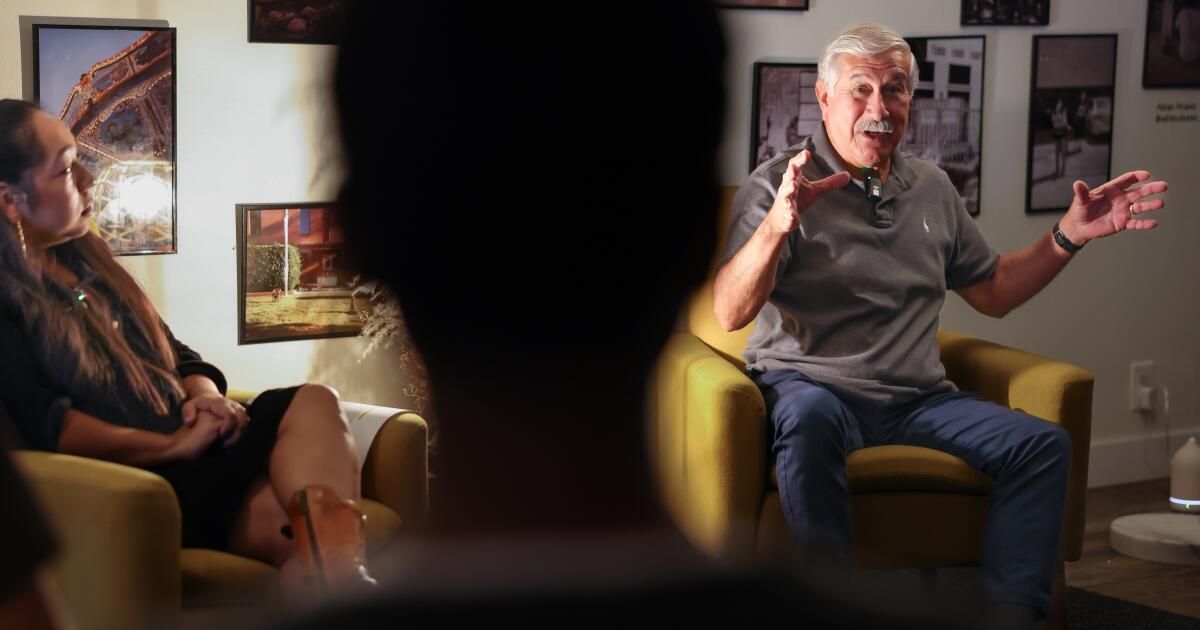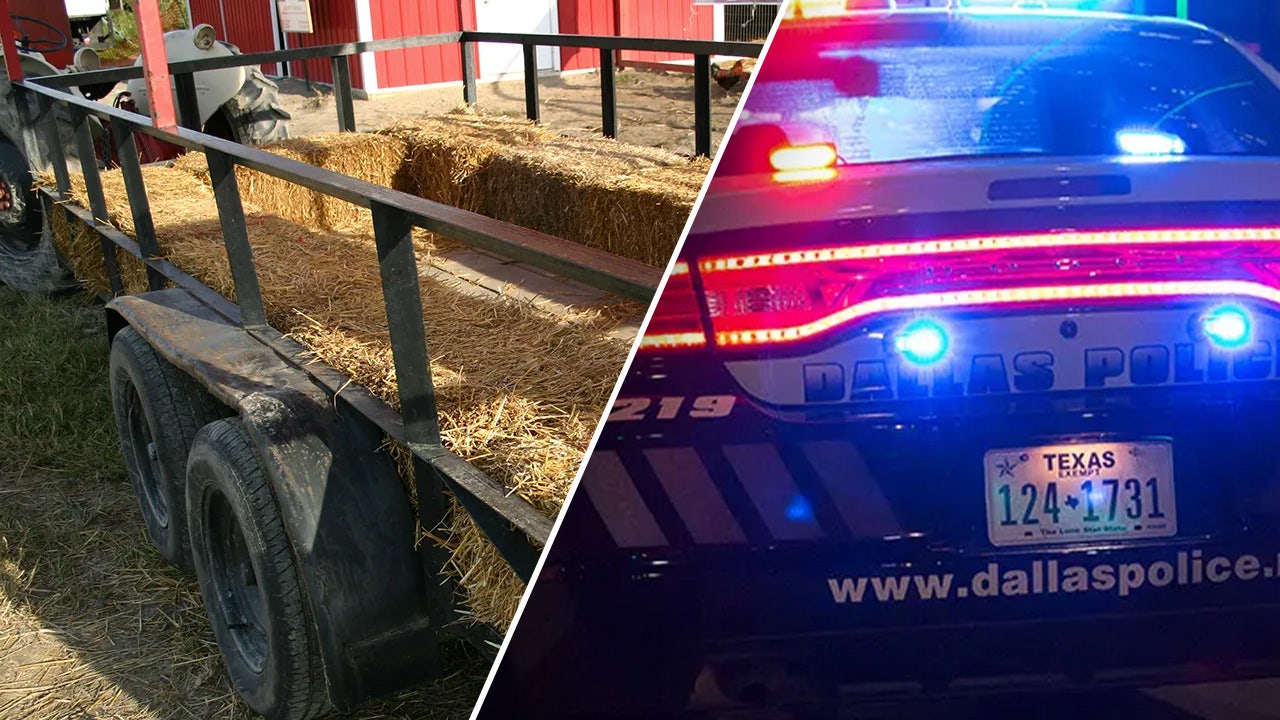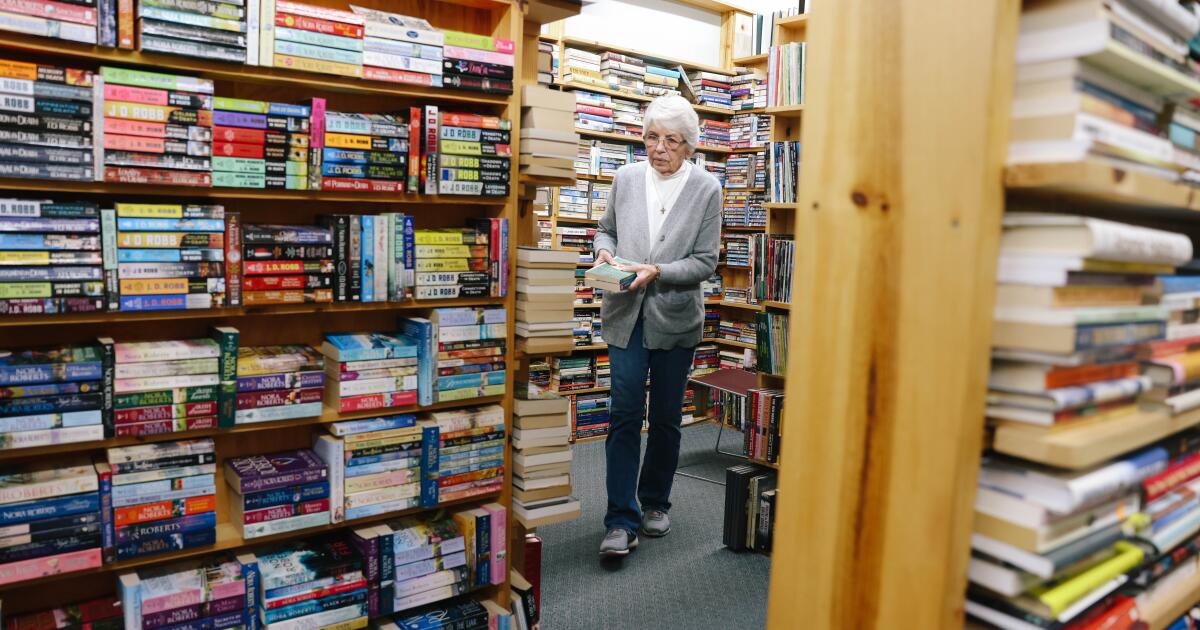Albert M. Camarillo is an old-school Compton.
His father emigrated from the Mexican state of Michoacán as a teenager in 1914, when Hub City was mostly farmland.
Camarillo remembers when the first black families moved into once-segregated neighborhoods in the 1950s. He served as student body president at Dominguez High as Compton was becoming a nexus of black life, and focused his first major college paper on the city’s transformation.
“Compton in My Soul: A Life in Pursuit of Racial Equality” is a paean to an often stereotyped place.
(Christina House/Los Angeles Times)
Since leaving Compton more than 50 years ago, he became a legend for his work on Mexican-American history and academic diversification, but his hometown never abandoned him. The retired Stanford professor’s recent memoir, “Compton in My Soul: A Life in Pursuit of Racial Equality,” is a paean to an oft-stereotyped place that changed dramatically again during his absence, from overwhelmingly black to overwhelmingly Latino. Camarillo traveled through California this summer to talk about his book, and his stop in Compton on Saturday was as pivotal a moment as could be written.
The location: Color Compton, a nonprofit in a shopping mall that uses art and history to engage local youth.
“I wish I had been here when I was a kid!” Camarillo told co-founder Abigail López-Byrd of the group, as they looked at photos of the city’s defunct downtown and the Compton Cowboys, a Black equestrian club whose motto is “The streets raised us. The horses saved us.”
“Most of the artists and photographers are from Compton,” López-Byrd said of the artwork displayed throughout the multi-room space.
Camarillo flashed the first of many smiles that would accompany him that day. The 78-year-old is tall and fit, and sports a bushy mustache and a mane of white hair that give him a more Mike Ditka-like air. He had shown me an early draft of his book and thanked me in the acknowledgments for the suggestions I made.
Lopez-Byrd, 33, is a native of Hub City, so named for its central location.
“It’s inspiring for young people to learn from people who come from the same place,” he said when I asked why Color Compton was hosting an event for Camarillo. “It makes goals much more attainable when you see people like you who have done the work.”
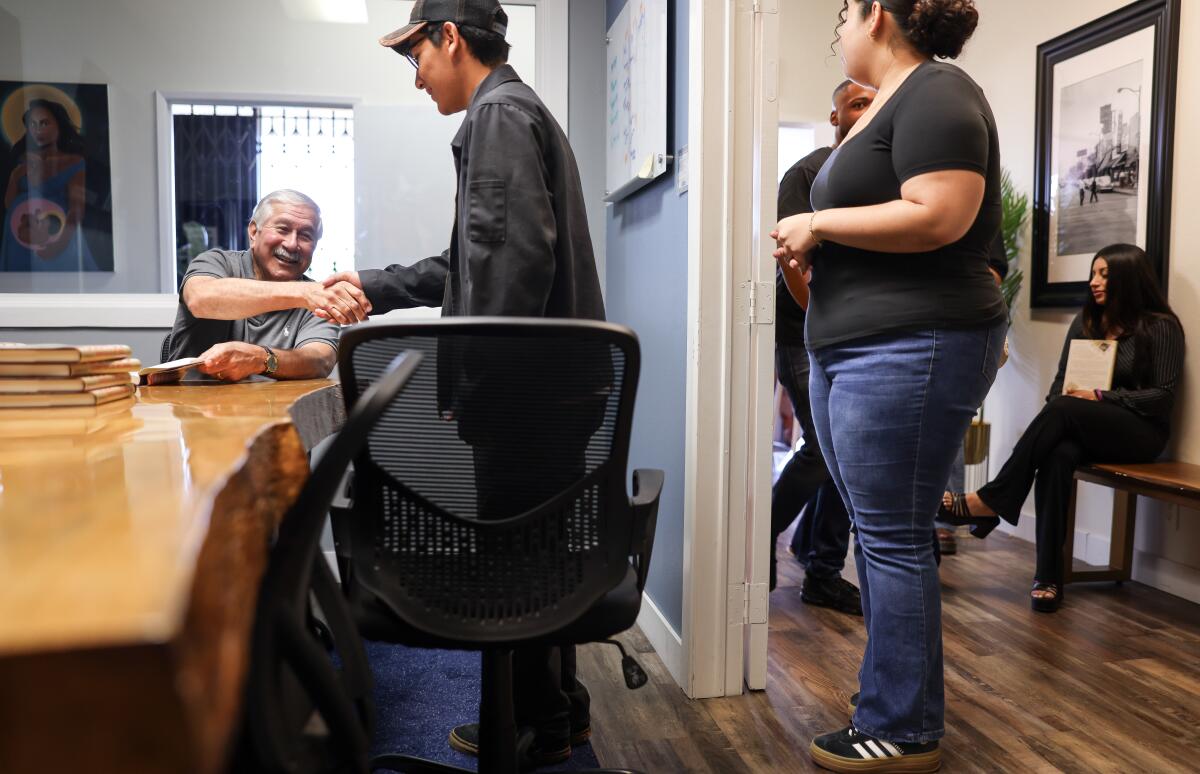
Albert Camarillo signs copies of his memoirs.
(Christina House/Los Angeles Times)
“I need to help them get a big grant to invest in what they’re doing,” Camarillo said as López-Byrd excused herself to speak with a volunteer. Earlier in the summer, Camarillo had hosted a group of Compton Color youth at Stanford. “This is something to talk about.” heart“It’s God’s work,” he told me.
We walked down the hall to a gallery displaying photographs of participants in the Color Compton Community Archives Fellowship. In front of the display were comfortable seats surrounded by lamps, where López-Byrd and Camarillo chatted. Across from them sat about 25 young people, most of whom were black, Latino, or both.
“How are you guys doing today!” Camarillo exclaimed before asking which high schools they had attended and receiving only a few whispered responses.
Anyone from Dominguez? A few hands went up.
“Well done, Dominguez High School!” Camarillo said as she raised her fist.
“It’s special for me to be here today, because I’m from here, so we’re all connected,” he began. “I don’t want you to think I’m the Stanford professor. I’m one of you, but I’m much older.”
The audience laughed and any generational skepticism that might have existed disappeared.
Camarillo went on to tell her Compton story: how her family settled in a neighborhood on the city’s West Side before an older sister bought a house on the white side in an effort to assimilate. How she grew up in a “Jaime Crow” era and how white flight happened “almost overnight.” She mentioned the schools she attended: Longfellow Elementary. Walton Middle School. Dominguez High, then UCLA.
He teacher He was never condescending, nor ostentatious, but instead let the course of his life provide all the drama and humor. When he said that leaving Compton allowed him to “understand where I came from” and inspired him to open the proverbial doors for others, young people nodded and leaned in to hear every word.
Outsiders have long seen Compton as a problem: a warning about demographic change, a code word for inner-city violence, a cautionary tale of what happens when minorities gain power. Camarillo and its people know a different Compton: a place of talent, pride and hope.
“They have an obligation to give back what they can,” he concluded. “That’s how change happens. I’ve seen it. I’ve lived it… It’s their responsibility to change the narrative of Compton.”
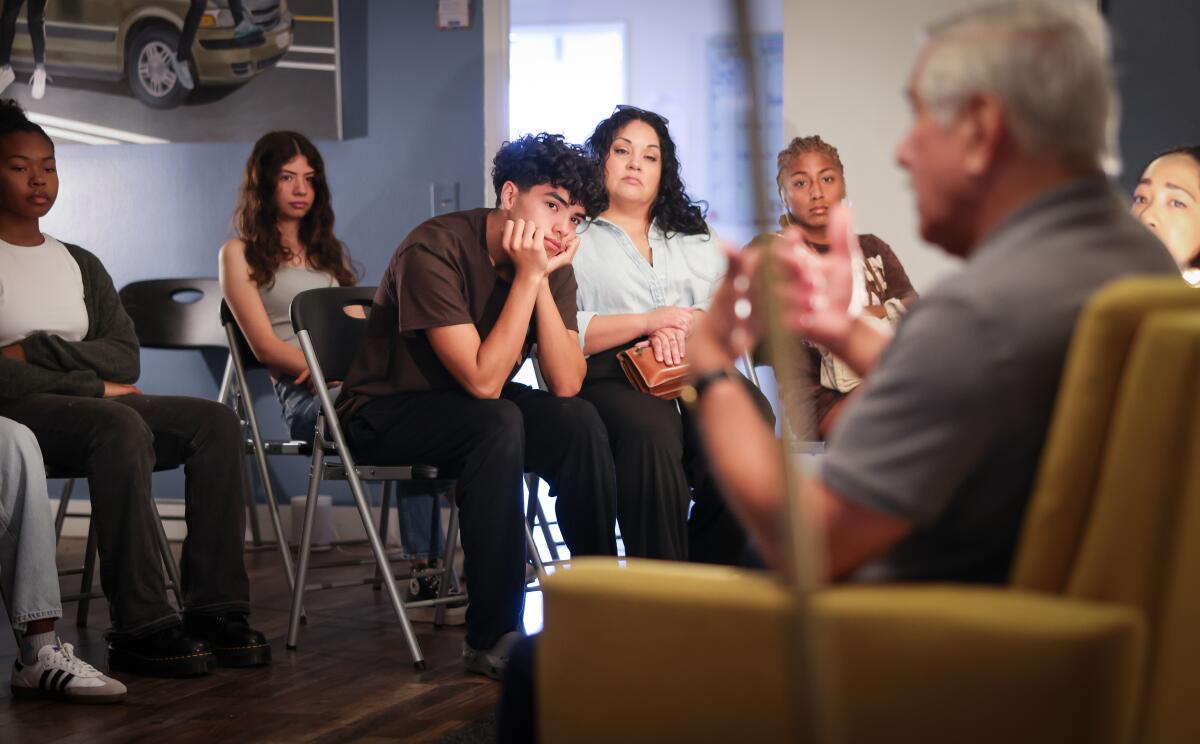
Albert Camarillo, right, speaks to a group of young adults at Color Compton.
(Christina House/Los Angeles Times)
Lopez-Byrd asked if anyone had any thoughts.
“I retired eight years ago,” Camarillo joked. “I miss being in the classroom. I need your feedback!”
There were questions about how he wrote the book and about his memories of the early days of the Chicano movement.
Courtney Watson, a 17-year-old Westchester High senior, asked about the time Dominguez High administrators turned to Camarillo to stop daily fights between white students and black students who were integrating into the school.
First, he recalled, all the athletes gathered at his invitation to discuss their differences. Then he called a lunchtime assembly. At the tense meeting, a black student said the legacy of slavery was the reason blacks continued to suffer discrimination. A young Camarillo dismissed her theory as false.
The audience gasped in compassion as Camarillo threw up his arms in disbelief. “I was so stupid, so naive!”
“Why did you say that?” Courtney replied, incredulous but understanding.
“I wish I could go back to that moment as an adult and tell myself…”
“Don’t say that!” Courtney added as her classmates laughed.
Someone else wondered how Camarillo was able to reestablish relationships in Compton after disappearing for decades.
Residents “can see when you’re not authentic and you’re a fake,” he acknowledged. One of his sons began teaching in Compton schools in the early 2000s, and another, former NFL wide receiver Greg Camarillo, created a nonprofit that has helped local student athletes. teacher He also connected with Stanford alumni who, like him, were from Compton, a network that, he noted, was larger than one might think.
“If you can win [the] “With the trust” of community members, he concluded, “we can help build something.”
Everyone gathered for a group photo and then Camarillo went to another room to sign copies of his memoir. An hour later, he was still signing books and engaging in deep conversations with each attendee.
“He mentioned things I never knew about my community before,” said Daira Castro, a 17-year-old Compton High senior.
“It was nice to see someone from the community who has been doing things for a long time at his level,” said Elvis De La Rosa, a 23-year Compton resident. “Everything he said was spot on. Every generation has new struggles to face, new opportunities to take advantage of and new ways to deal with them.”
López-Byrd then asked Camarillo to listen to the fellow community archives workers who had taken the gallery photos. The bygone Comptoner stayed for another hour. He never once looked at his phone or wristwatch as the young photographers discussed his work. Never once did his bright eyes and warm smile fade.
“It gives me inspiration and a sense of hope to see them so excited about [documenting] “And living here,” Camarillo said when the presentation was over and the room, now packed with family and friends of the photographers, erupted in applause. “That’s what I’m taking with me from here today.”
Lopez-Byrd received one last invitation. We headed down to the Compton Museum of Art and History, which she co-founded with her husband, Marquell Byrd. Photos, paintings and multimedia works by black, Latino and Asian American artists addressed the idea of Compton’s “single narrative” of racial violence and conflict. Camarillo put on her reading glasses and slowly made her way through the gallery.
“This is what I said, what I wrote,” he said finally, smiling again. “There is super creative material. It’s amazing!”

